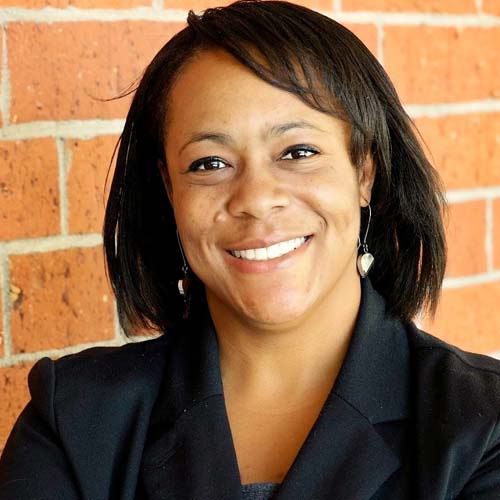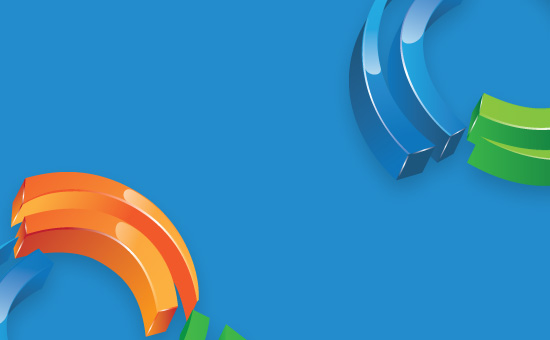Exploring Liberation and the Decolonization of Sign Language Interpreting
Erica West Oyedele presented Exploring Liberation and the Decolonization of Sign Language Interpreting at StreetLeverage – Live 2017 | St. Paul. For this presentation, Erica sheds light on the experiences of marginalized students in interpreter education programs and challenges educators and practitioners to rethink how we achieve diversity in the field.
You can find the PPT deck for her presentation here.
[Note from StreetLeverage: What follows is an English translation of Erica’s StreetLeverage – Live 2017 presentation. We would encourage each of you to watch the video and access Erica’s original presentation directly.]
Interested in attending StreetLeverage – Live 2018 being held in Philadelphia, PA/Cherry Hill, NJ (metros) April 13-15, 2018?
Exploring Liberation and the Decolonization of Sign Language Interpreting
Trigger warning
This presentation will focus on the experiences of sign language interpreters and Deaf people who come from marginalized backgrounds – interpreters of color, Deaf people of color, Codas, persons who are income insecure, persons who are DeafBlind, and so on. As a part of my work I have been able to have conversations with people from these communities, and before I continue I must acknowledge how honored I am that individuals have been willing to share their stories with me. Now, I would like to share some of those stories with you.
For those of you who come from marginalized backgrounds, you may find some of these stories triggering. For everyone else who is present, you might also find yourself faced with discomfort as you listen to these stories and see them through a different frame. A common reaction to this discomfort is to respond in defense of behaviours that were not intended to do harm. If you notice your defense mechanisms kicking into place, I would like to ask that you try to place your defensiveness aside and authentically listen with an open heart and mind to this discussion.
Before we continue I am going to show you two common images that you may have seen before. They have been widely disseminated throughout the internet and frequently used in instruction. If you have seen these images before, I want you to look at them again, but this time as you look at these images, I would like for you to consider their application to the field of sign language interpreting.
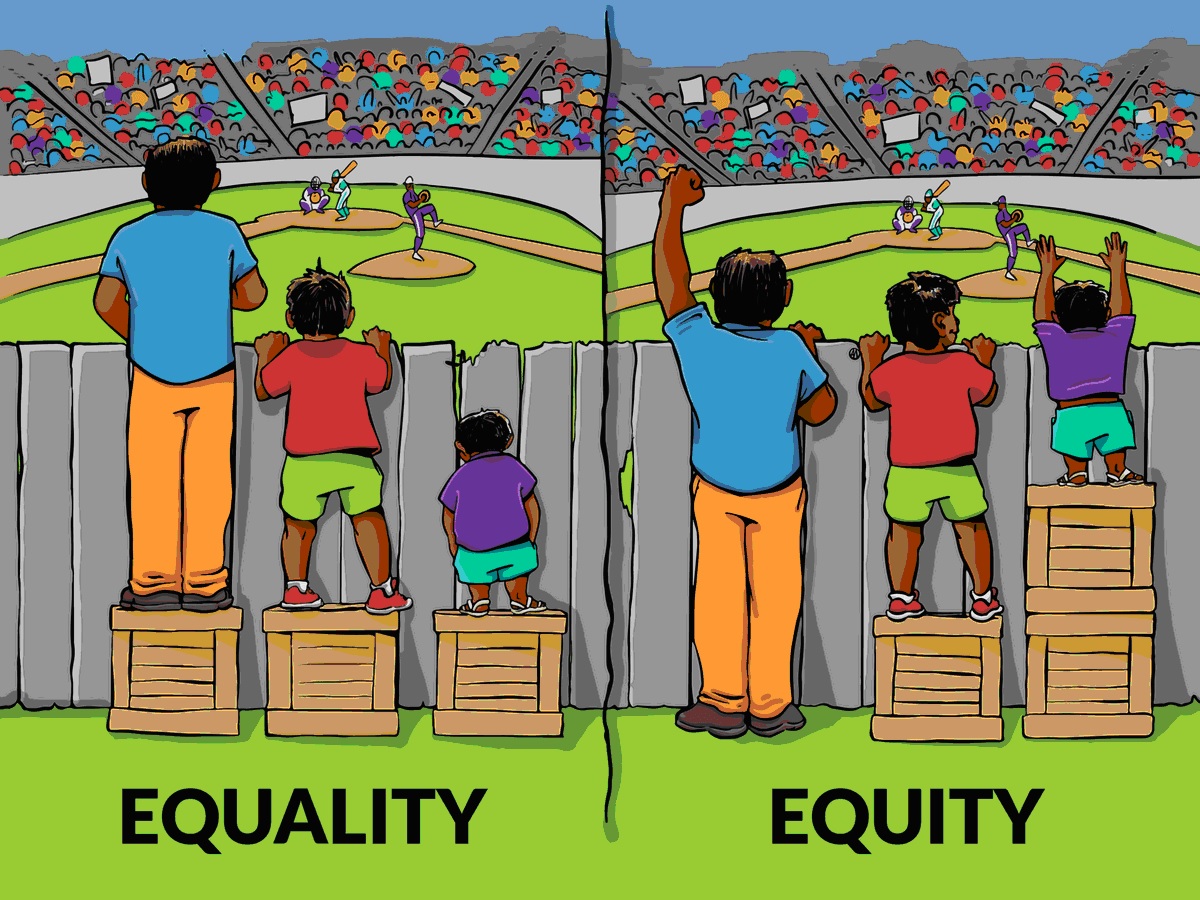
Again, many of you may have seen these two images or similar ones in the past. In these images, we see a visual representation of equality juxtaposed with a visual representation of equity. I would like to describe what comes to mind for me as I do an analysis of these two images.
Equality
In this image, I see that there are some individuals who have obvious access to the system while there are others who are marginalized, or outside of the system. Those individuals who are outside of the system have varied levels of access. There are somewhere it is apparent that no access exists, and there are others who have gained some access but have to work at maintaining the level of access that they have; they have gained some level of entry but they don’t have full access. So there are those who have full participation in the system, some who are prevented from participating at all, and then everyone else in between. I can see how this image serves as a metaphor for the field of sign language interpreting and interpreter education.
Let me share some examples to illustrate this. Keep in mind, these examples do not come from the research I conducted a few years ago. Rather, all of these examples are based on real recent events or conversations. For example…
- Over the last two weeks I have watched as Deaf and DeafBlind people of color and interpreters of color have tried to express why the use of the “n” word is harmful. I have witnessed their pain.
- A teacher recently approached me to tell me that a student of theirs left a note that they had a hard time with their assignment because they did not understand “dark hands”. By the way, this is not the first time this type of comment has come up.
- I can speak from personal experience when I say I have witnessed Deaf students who tell me that the hearing students in their cohorts who have learned about Deaf culture continue to use simultaneous communication in the classroom, or worse, they use their voices freely outside of the classroom. It isn’t until they see a Deaf person approaching that they suddenly flounder to shift modalities and start signing. I can only imagine how that would make the Deaf person feel.
- A trilingual interpreter recently shared with me that they knew they would never be “good enough” as an interpreter in this field. They acknowledged that because English is not their first language, that they would never be accepted. Not fully. Perhaps we can make a connection here between this comment and the previous presentation on language shaming.
- I believe this is made worse because I have also been told on different occasions by trilingual colleagues who have a first language other than English, that when their anxiety is heightened, their accents become more thick. Teachers and students looked down on them and their abilities to perform as an interpreter and this can be something difficult to overcome. They are stymied at how to address the power dynamics that exist in these situations.
- Another recurring narrative comes from Deaf interpreters, Coda interpreters, and interpreters of color. Individuals who come from these marginalized communities may have just graduated or are still acquiring the necessary skills to work effectively as an interpreter, and when a job comes up requesting an interpreter from these demographics these new interpreters are placed on high profile assignments before they are ready. As a result, the field perpetuates this belief that Deaf interpreters are unnecessary, that Codas are unprofessional/unethical, and that interpreters of color are lacking in skill. This myth is perpetuated because we are placing interpreters from these backgrounds before they are ready. And yes, this does happen to our colleagues who are not from these backgrounds as well. The difference is when this occurs with hearing, white, interpreters who have acquired ASL as a second language, the impact is different because they are a dominant force in our field and therefore their actions don’t overshadow their entire community.
- I’ve seen students who want access to formal interpreter training be prohibited due to the costs associated with accessing our programs and institutions. The costs of books and workshops can be enough to push out potential new interpreters. Or, these interpreters have to find other unconventional means for acquiring their training that are often not recognized in our field because of the value placed on formal education within our field.
All of these narratives are a little frightening and a little bit dangerous if you ask me because the Deaf community is wonderfully diverse yet the potential for greater diversity within the interpreting field is lost when we do not do enough to support sign language interpreters who come from marginalized backgrounds.
The implementation of a “one size fits all” approach to pedagogy; that is what I see when I look at this image of equality and what comes to mind when I listen to the narratives that have been shared with me.
So let’s look again at these two images:

Equity
Now, my actual belief is that those of you who are here, whether you hold a position as an educator within an IEP, or you work as a mentor, or if you are just engaging in discussions with colleagues, I don’t think that you actually believe in a one size fits all approach to interpreter training. I think we do look at individuals as they come to us, try to identify what their unique needs are, and make decisions based on those needs. And though we are trying, I still see a wall present. There are still institutional barriers in place that prevent some from gaining access to the system while allowing access for others.
An example of how we try to accommodate individual needs as they come to us is evidenced in what for me has become the familiar narrative of recognizing the unique experiences of interpreters who have different linguistic and cultural backgrounds than us. We tell them to find a mentor who shares their same background so they can be mentored by someone who has had a similar journey. Maybe we agree and validate their experience of being isolated as a person of color in an interpreting program that is taught predominantly by white instructors. We encourage these students to persist and then to go out and become educators themselves. We recognize that we don’t have it all and we tell them to go, do, or become something so that they can solve the problem that we cannot. But our answers to have them go, do, and become something different minimizes and oversimplifies the actual issues that are present. These responses don’t take into account the additional trauma, suffering, and adversity that people from marginalized backgrounds must face to get through such systems, nor does this response acknowledge the likelihood that we might lose them from burnout well before they reach whatever point we have set out for them. Not to mention the additional complexities involved with being the only teacher of color, or only Deaf person, or only Coda. It can feel like you are on an island, alone without a functional support system.
Sometimes people ask why we continue to have these sorts of discussions. It is because these discussions are instrumental if we are to acknowledge that who we are, and the cultures and backgrounds of the people who are teaching us have an influence on how we learn and what we learn. For me, both the image of equality and equity represent struggle, marginalization, and problems within the structure of the system; in short, both images represent colonization of the interpreting field.
I think now is the time to share a couple of quotes. One quote comes from the NCIEC trends report that was recently released. They had a focus group that consisted of interpreters of color, and one quote that resonates for me from that group was that their experience with interpreter education was that interpreter education was, “white hearing students, learning about white Deaf culture, from white hearing instructors.” I am not trying to place blame on people who are white, but I do want to acknowledge that, that is the system. That’s where we are right now.
The other quote comes from Kirsten Muroski’s presentation just moments ago. “When I look around, I sure do see a lot of white people.” Now, remember, she said it. Not me.
Time for a check-in, I hope you have not completely shut me out at this point. If you’re feeling defensive, try to acknowledge that and put down your guard. Stay present with an open heart and mind because these are the stories that are coming from marginalized people.
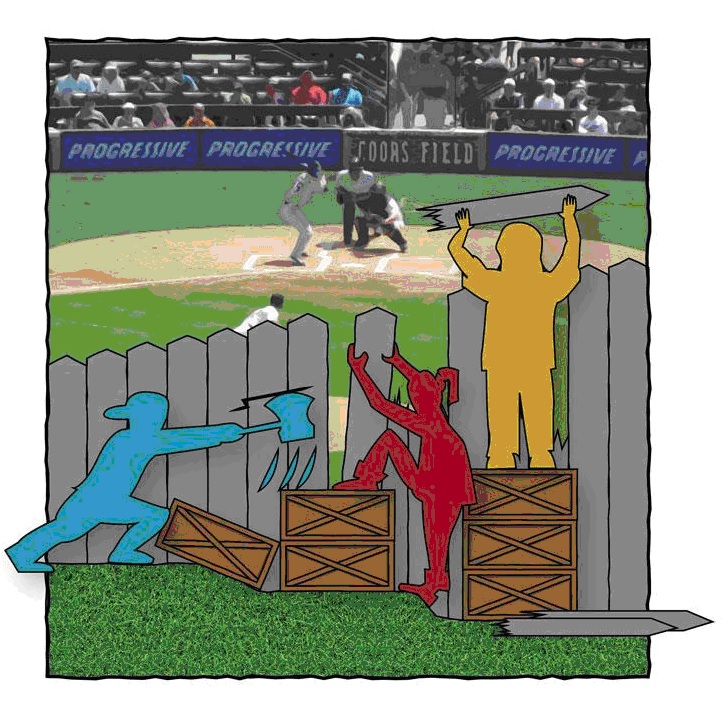
Working towards social justice
If the previous images of equality and equity represent the colonization of the field of interpreting by predominantly white, hearing people who acquired ASL as a second language, then what could the image you just saw represent? Some of you may look at the image and see violence, but that is not what I see. What I see is the intentional decision to create change, an intentional decision to not continue to tolerate a system that is ineffective. I see people who have continued to struggle in fighting for their rights, decide to say that this system is not working for us, and therefore we are going to create change.
At the same time, I can respect that many of us have invested ourselves into these broken systems. The thought of tearing them down is not something that can be easily accepted. Criticism of “the system” might feel like criticism of oneself. We’ve spent time and energy investing in a system that I am now suggesting be torn down for the purpose of improvement and change, but what about those who have given so much already? I recognize the complexities of this, and at the same time, I think that we have to look beyond our individual selves towards the collective impact and harm done to marginalized communities.
So when I am told that someone has said they “don’t understand dark hands”, what does that mean for Deaf people of color? The Deaf community is not a homogenous group. If we don’t take this into consideration then we are doing what Tom just said, putting in warm body interpreters. That’s not fair to Deaf people of color. It’s well known by now that language and culture have an effect on each other so we must continue our work to become more culturally competent as interpreters and educators.
Acknowledging barriers
So with this type of presentation, I list off a whole host of problems and the natural reaction from the audience is that they want solutions to these problems. So, if at the end of this presentation you are inclined to come towards the stage and ask me, “what can we do?”, I’m telling you straight up right now, that I don’t know. I don’t think we have to have answers yet for issues that our field is still really just starting to acknowledge. We need to acknowledge the barriers before we start trying to jump towards solutions. You can’t fix the leak if you don’t know where it’s coming from. What we can do is continue to critically assess the systems around us, ourselves, and how we contribute to those systems. That should be our ongoing work.
I do have a few ideas though. First, I think we can acknowledge that the demographics of our profession create a problem. While there is no easy answer, I do think we can think a little more broadly about how we recruit into our field. We cannot begin our recruitment in advanced ASL classes (ASL 4 & 5), we need to start in entry-level ASL classes and show up at high school career fairs, and let’s make sure we are making efforts to reach out to schools, colleges, and universities that have a higher concentration of students from underrepresented populations. Let’s make sure people in those areas know about the profession.
Many of us can relate to the conversation of language shaming. Let’s acknowledge Coda interpreters and Deaf interpreters who have “it” but even more specifically let’s not overlook Codas of color and Deaf people of color who are not persisting in this profession. There was one quote in particular from my research that had an impact on me and this conversation. There was a Black Coda who shared that they entered their interpreter education program and when they would sign with their native language of Black ASL, they experienced constant criticism. As this interpreter continued to be corrected, they realized that the language that they were using and the language that they learned from their parents was wrong. They changed how they signed. It was not until after their parents had passed away that the literature on Black ASL was published and validated the language of this Coda and their parents. This is more than language shaming, it’s denying a culture and does not serve the community well.
When we tell students to go find a mentor who shares their same background, for these interpreters from marginalized communities the question is often, “Where can I find this person?” What we need to do is focus on connecting interpreters of color with communities of color. We should make sure that they know about NBDA, Council de Manos, and other organizations that serve people of color so that interpreters can understand “dark hands”.
I, too, have created barriers. I was taught to only mentor interpreters who had gone through formal interpreter education. Mentoring interpreters without any formal training really becomes less about mentoring and more about teaching. That is what I believed, but over time my thoughts on this have changed. If we limit mentoring to those who have only sought formal interpreter education, then we miss opportunities to bring in Deaf interpreters and Coda interpreters, and we show a lack of value for those with grassroots experiences who we should be welcoming into our field.
A friend of mine from grad school, Sandra Maloney, is preparing to publish her thesis. She conducted a survey of educators who teach in interpreter preparation programs. Of those who responded to her survey, forty percent are not members of professional organizations like CIT and ASLTA, organizations that disseminate research. This is an issue, too. We are at a place in the field of sign language interpreting where we have more interpreters graduating from master’s programs and they are publishing research. In particular, we have people from marginalized groups who are providing us with insight into their experiences. Insight that we can learn from. We should be looking at this research and assessing the current curriculum in IPPs to see where we might make modifications to the curriculum and to identify areas where a complete overhaul is needed, too.
I also don’t want to overlook the saturation of women in the field of sign language interpreting and what that means in terms of how trauma impacts our work. Statistics show that somewhere between one-fifth to one-half of women have experienced sexual violence. I think we need to have a conversation about how that trauma impacts our field and how that trauma is compounded for individuals like women of color, who have multiple marginalized identities. We are the ones present at Black Lives Matter rallies, going out to protest the Dakota Access Pipeline. When we are at a place where many of us from these marginalized backgrounds are marching and protesting for our rights, we also have to be mindful of our safety, trauma, and how that impacts the interpreting field. My main point here is that as we navigate this world, we bring all of the complexities that come with it, in terms of power, privilege, our own baggage. All of it comes with us when we become sign language interpreters and so we need to think about how the greater sociocultural context in which we live impacts our work as interpreters.
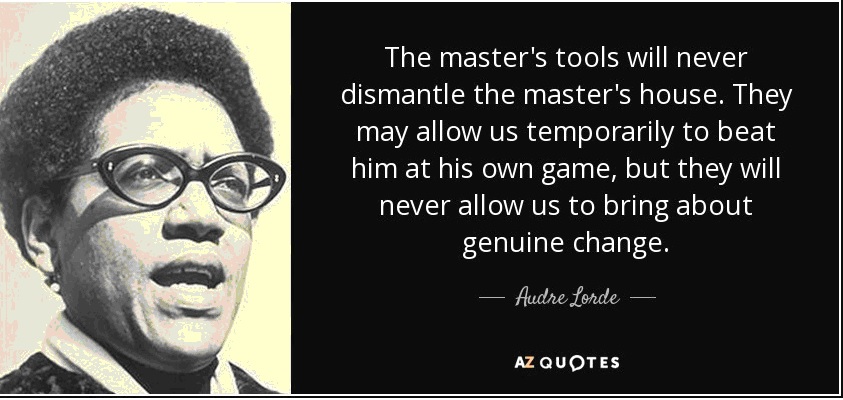
We’ve identified that there is a system setup that is problematic. We need to ask ourselves; we need to ask each other…is it possible to make changes within the current system so that it can be more effective, or does the system, as it is, create so many challenges that it needs to be torn down? Do those of us from marginalized communities need to find a place of our own or can we, as a field, work together towards change?

What are you working towards?
I’m going to close by asking questions of all of you. In the work you do every day as interpreters and as interpreter educators, what are you doing to show that you value social justice? What are you doing to make sure that individuals from marginalized communities are included in the work you are doing? Does your IPP have a wall? Are you creating barriers or are you working to tear those barriers down?
Thank you.

